The Hole Truth

In a split second an entire city goes dark, a building explodes, 911 lines go dead and a town’s water supply stops. The culprit? A seemingly harmless shovel or backhoe that unintentionally damaged buried electric, gas, telephone or water lines during construction operations.
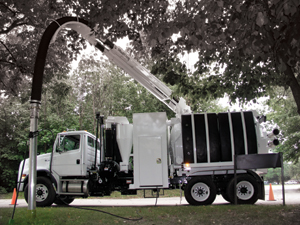 There are approximately 680,000 incidents of damage to the United States’ utility infrastructure annually. With the country’s accelerated expansion of underground utility lines, including telephones, electricity, gas, cable TV, fiber optics, drainage and flood control facilities and water mains and waste water pipes, opportunities for damage have grown exponentially. Faced with the risks of everything from construction delays, insurance claims and property damage to the disruption of business, injuries and lost lives, contractors are increasingly adopting risk-eliminating hydro excavation solutions.
There are approximately 680,000 incidents of damage to the United States’ utility infrastructure annually. With the country’s accelerated expansion of underground utility lines, including telephones, electricity, gas, cable TV, fiber optics, drainage and flood control facilities and water mains and waste water pipes, opportunities for damage have grown exponentially. Faced with the risks of everything from construction delays, insurance claims and property damage to the disruption of business, injuries and lost lives, contractors are increasingly adopting risk-eliminating hydro excavation solutions.
“Damaging utilities has far-reaching, expensive consequences,” says Kim Wehse, President of Wisconsin Utility Exposure Inc. — the oldest hydro excavation company in Wisconsin — that has exposed over 80,000 buried utilities without causing any damage since it was founded in 1999. “In one case, an hour after [WUE Crews] left a casino jobsite, a construction worker [employed by the contractor] continued working with a shovel, hit an electric power line and shut down the entire casino. That meant that the construction company had to compensate the casino for lost food, employees’ salaries and the amount of revenue it lost due to the forced closure.”
Hydro excavation is a non-destructive process that uses pressurized water and a vacuum system to remove soil cover to expose underground utilities with virtually no risk of damage. In addition, the process enhances productivity, reduces labor costs and minimizes site restoration expenses.
Ditch the Shovel
While all states have a call before you dig (811) hotline for contractors to have lines located, the service will locate lines, but will often not verify depth. Although there are depth minimums for utility line placement, there are no standards for maximum depths.
Then, faced with the challenge of locating the lines, contractors are mandated to hand dig 18 in. on each side of the line to prevent damage. Traditionally, this required a person with a shovel to gently probe for lines as the ground was removed. However, this process was time consuming, resulted in high labor costs and did not eliminate the possibility of damage.
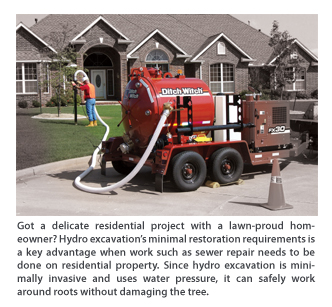
“Since directional drilling became popular and no depth standards were in place, lines were buried deeper and deeper,” explains Wehse. “When [WUE] is called out to expose a line, our first job is to locate it. At times the original installation plans aren’t available or we learn that they are not accurate.”
While backhoes are faster and more efficient when the assignment is moving a great deal of rock and soil, they need more space to maneuver. Even if an operator is extremely proficient in handling the equipment, it is very easy for the backhoe to catch a rock and have it push through the pipe. By using hydro excavation to expose utility lines, a backhoe can then proceed with the excavation with the assurance that no lines will be damaged.
Another advantage of hydro excavation is that it minimizes site restoration work. For example, if a backhoe was used to expose a pipe under a sidewalk, two to three slabs of the sidewalk and possibly a street light would have to be removed. With hydro excavation, only a hole big enough for a person to access the pipe is required.
With the growing emphasis on environmental protection, municipalities are becoming more stringent in protecting their trees when utility work is being done. Since hydro excavation is minimally invasive and uses water pressure, it can safely work around roots without damaging the tree.
“Hydro excavation’s minimal restoration requirements are a key advantage when work such as sewer repair needs to be done on residential property,” says Wehse. “Unlike a backhoe, our equipment can remain on the street since only the hydro excavator’s lines cross the property. We can complete the work and once we leave the location, no significant restoration needs to be done.”
Down to Earth
There are hidden challenges when working under the streets of a city and urban area. Marked by extreme congestion of electric, gas, cable TV, fiber-optic phone, water and sewer lines, it’s work that must be done with surgical skill to ensure that all the critical systems remain in service. Safe, efficient hydro excavation depends on the operator’s skill level and experience and the capabilities of hydro excavation equipment.
When exposing buried utilities with hydro excavation equipment, you have to give careful consideration to the types of applications you’ll be working on, as well as the weather and soil conditions. Vacuum systems may have been designed for the specific use of sucking mud, but manufacturers like Super Products Ditch Witch, McLaughlin, Vacmasters, VacStar and Vac-Tron Equipment have seen their customers diversify vacuum applications. Mirroring that trend, the customer base has also grown from primarily construction contractors to utility owners, municipalities and landscapers.
“Knowing that our customers would be in the Midwest, where soil conditions aren’t predictable, we’d need to be prepared to work with sand, clay and rock,” says Wehse. For optimum hydro excavation flexibility, WUE turns to a positive displacement blower system to handle whatever its crews encounter. Unlike a fan system that pumps air, positive displacement puts an 8-in. vacuum line on a large 200-lb rock, creates a solid vacuum, picks it up and takes it right out of the hole. Without that ability, you would have to start a new hole or make a much larger hole, which would slow down the process and make you less efficient.
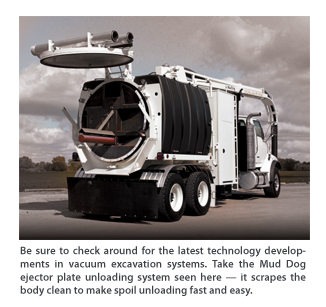
Another aspect of the system to take note of is the tank capacity. Standard spoils tank sizes are 100 gal, 250 gal, 800 gal and 1,200 gal. The 100-gal tank is small enough that it can fit in the bed of a pickup truck. Jobs that require a tank larger than 1,200 gal usually require the large scale truck-mounted systems built by Vac-Con Inc., Vacutrux, Vacmasters, Super Products and Vactor Mfg. Those vacuum systems cost as much as $400,000 and are almost exclusively used in sewer projects.
Vacuum systems are well suited for individual construction or landscape crews because they can often be purchased so that the total weight of the unit, skid or trailer and truck all weigh less than 10,000 lbs GVW, avoiding the necessity — and expense — of a commercial driver’s license (CDL) to haul it from the storage garage to jobsite.
Trailered vacuum systems can be purchased to weigh less than the 10,000-lb GVW (with truck) CDL limit, but range up to 24,000 lbs of GVW. The operator will need to size the trailer to the type of truck used.
Units are typically sized by the capacity of the spoils tank and blower power, which creates the airflow needed for suction. Vacuum systems range in price from about $14,000 to $80,000, depending on size, options and any additional accessories — like neoprene ends on water lances and dig tubes instead of metal tips that can easily puncture lines.
“Since the complexion of our infrastructure is changing and critical services are now located underground in a very small area, especially in densely populated areas, hydro excavation’s ability to eliminate utility line damage is becoming more and more valuable,” says Wehse.
“Not only is it an efficient method, but it also offers a safe, cost-saving solution to the challenge of locating the utility lines that are providing critical services to individuals and businesses.”
Barb Cooper is the President of Barb Cooper Communications, based in Browns Point, Wash.
Sucking Up Options
Vacuum units typically come standard with a suction tool and spray wand. But if you really want to trick out your vacuum system, there are a number of accessories and features that can be fitted to the unit to boost its efficiency and versatility.
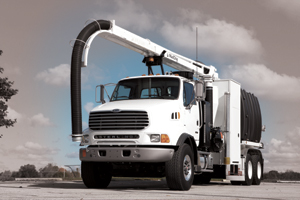
A vacuum boom can help operators manage the suction tool more freely. An extension arm rises from the top of the unit and uses hydraulics to raise, lower, extend and retract, as well as allowing rotation around the vacuum.
A sewer jetter is a tool that hooks the vacuum’s water hose and sprays water in multiple directions to break up a clog in a sewer pipe. A pavement sweeper attaches a squeegee-like tool to the system to help vacuum mud and other debris from streets, sidewalks and parking decks. A “two-in-one” tool is used for potholing work. The tool hooks the water stream and vacuum together so that the operator can spray water then vacuum at same time.


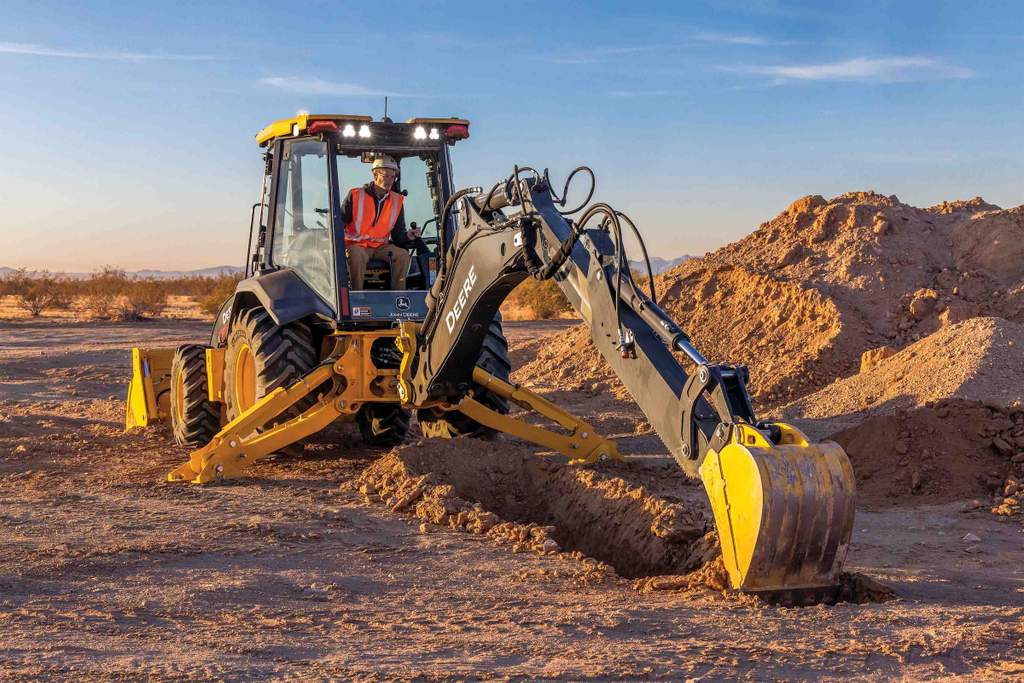


Comments are closed here.